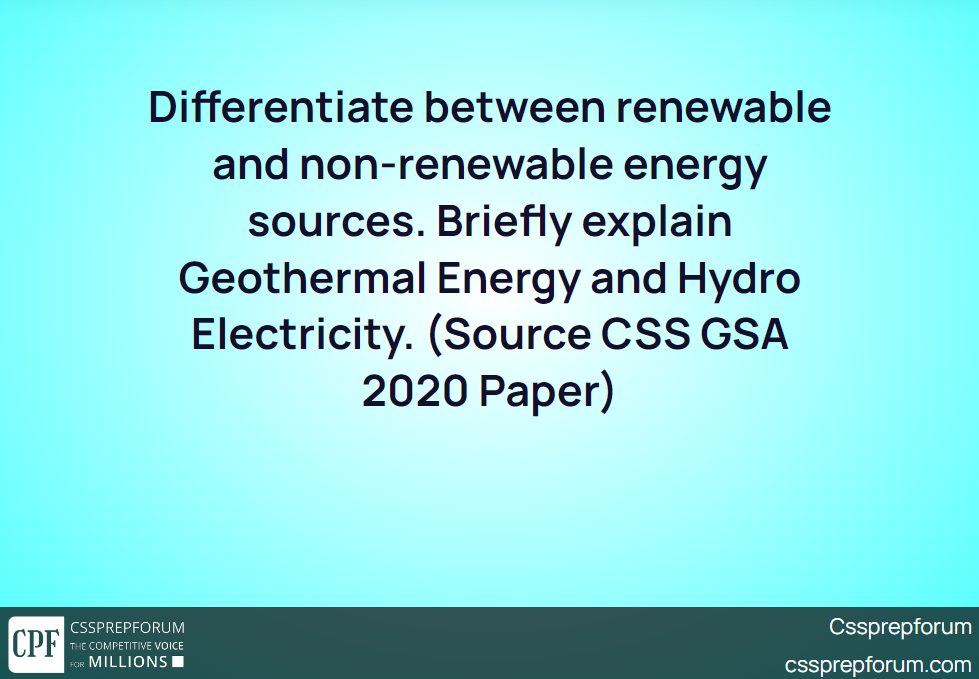Written By Khuleed Bin Mehboob
Difference between renewable and non-renewable energy sources
The natural power that empowers day-to-day activities fulfils industry needs, and supports society is energy. Sources of energy known to mankind are generally two in number: renewable energy sources and non-renewable energy sources. Renewable energy sources can extensively be produced by nature upon their consumption, whereas non-renewable energy sources are those that deplete upon usage with time.

Renewable energy:
As described above, renewable energy is endless and has existed since the creation of the universe. Particular examples of renewable energy sources are wind, solar, geothermal, hydropower, and biomass. According to environmental impact, renewable energy sources are environment friendly since they emit low carbon content – a global warming ingredient – to the environment. However, to install the initial setup required to use renewable energy, a tremendous amount of investment is needed. Furthermore, potentially renewable energy potential is not globally available.
Non-renewable energy:
Contrary to renewable energy, non-renewable energy has been consumed by man since its discovery. Crude oil, natural gas, coal, and nuclear energy are some forms of it. Where low carbon content is associated with renewable one, non-renewable energy emits high carbon content, posing a threat to the environment. Non-renewable energy, unlike renewable energy, has low initial investment and low energy generation costs. The world is concerned about the environment’s unfriendly impact of non-renewable energy sources since a great many countries use non-renewable energy sources to meet their demands.
Briefly explain Geothermal Energy and Hydro Electricity.
Geothermal energy and hydroelectricity are sources of renewable energy. Their explanation is hereunder:
Geothermal Energy
The earth that sustains life is scorching at the centre, which is far deep from the earth’s surface. Sometimes, the heat travels from the centre to the surface in the form of volcanoes molten lava. The heat can, after that, be used either to generate electricity or to heat cold water and any building. Such thermal energy – heat energy – of the earth is termed geothermal energy. It is green energy, together with less or zero harmful emissions, that cast an adverse impact on the climate.

At major, there are two ways to employ geothermal energy:
- Geothermal heat pumps:
Gaining of geothermal energy by heating or cooling water according to winter or summer season need is possible through geothermal heat pumps. By the above-stated method, not only the water is heated but also the air can be conditioned that further can help to achieve a comfortable temperature zone in the building or at home.
2. Electricity generation:
Other than geothermal heat pumps, the thermal energy can efficiently be accounted for electricity generation by the power plant. Hot water, directly beneath the surface of the earth ranging from one-two miles, is extracted upwards and is converted into steam. The steam, thus, is used to produce electricity. Such power plants are called dry steam power plants. On the other hand, the power plants that work on heat, which lies deep underneath the surface of the earth, are termed flash steam plants.
Hydroelectricity
Water at a fairly high level in a river, carrying potential energy, can effectively be used to generate electricity. The phenomenon is called hydroelectricity or hydropower. The phenomenon can, equally, be extended to the concept of usage of the flow carried by running river water. Either of the two methods, falling or flowing, are viable to generate electricity, water produced. Basically, three techniques are in there for hydroelectric power generation:
1. Storage system:
Dam, which is a reservoir, controls the river flow and creates an artificial lake on the river. While doing so, water is concentrated at a significant height, and, when needed, excessive water is dropped down from the higher side of the dam to the river below. The stored water, afterwards, moves through a pipe called a penstock and runs a turbine installed at a lower level. The running turbine is coupled with an electricity-producing generator. Dams not only help to generate electricity but also rein the flooding water.
2. Run-of-the-river hydropower system:
Having the same purpose but different infrastructure like the storage system, the run-of-the-river system is a method of diverting a small portion of river water to generate hydropower without affecting the river flow. Run-of-the-river system, unlike storage system, has, therefore, less electricity production capacity.
3. Pumped Storage System:
Pumped storage system, together with electricity generation, is designed to transport the water against gravity, i.e. from the lower level to the higher reservoir. The transport of water is done to use the water potential due to height. Such flow constitutes an energy cycle that improves hydropower plant efficiency.
Conclusion:
Renewable energy sources, unlike non-renewable energy sources, are eco-friendly and perpetual. Hydroelectricity and geothermal energy have significant potential to take part in energy fulfilment. Therefore, depending upon the availability of it, the renewable energy source can be explored and used efficiently.

Breakdown of asked question
Dear aspirants, to crack paper of general science and ability (GSA), you have to be relevant, scientifically, about what is asked. First, we have to understand the question by breaking it down to parts, making it comprehendible.
The question carries five marks and is bifurcated into two main portions as “Differentiate between the renewable and non-renewable energy sources,” and “Briefly explain Geothermal Energy and Hydro Electricity.” It is evident that the first part possesses two marks; on the other hand, the second part carries three marks, that is the equal distribution to both subparts.
To attempt the first part of the question, you need to define renewable energy sources and non-renewable energy sources. Two to three lines are enough while defining. Next, you need to present differentiation between the two either in the form of two separate paragraphs for each or in the form of a table.
Finally, you have to elaborate hydroelectricity and geothermal energy source as I have made it for you.
CSS 2022 Solved Pakistan Affairs Past Papers
The following are the CSS 2022 Pakistan Affairs solved past papers questions. These questions have been evaluated and checked by Pakistan’s top Pakistan Affairs and Current Affairs coaches, who are either lecturers or officers and scored the highest marks in this paper. They include Miss Saba Baloch (CSS-2021), Miss Aimeen Mirza (CSS 2018), Miss Nirmal Hasni (DD NAB), Sir Rameez Ch. (Lecturer & Deputy Director), and Miss Zaineb Azam (the highest scorer – 76). Moreover, these questions have been attempted on the same pattern taught by Sir Syed Kazim Ali to his students who have been scoring the highest marks for years.
CSS 2021 Solved Pakistan Affairs Questions

More Essays
- Meaning Purposive Education
- Bureaucracy Doldrums
- Is Gender Equality a Myth?
- Pros and Cons of Globalization for Pakistan
- Islamophobia: Causes and Consequences
- Artificial intelligence: Its Merits and Demerits
- IMF Bailouts: Roads to Stability or Recipes for Disaster
- Can Foreign Aid Help A Country Achieve Economic Stability?
- Consequences of American Withdrawal from Afghanistan on South Asia
- Money And Success Do Not Change People; They Merely Amplify What Is Already There
- Almost Always, The Creative, Dedicated Minority Has Made The World Better












